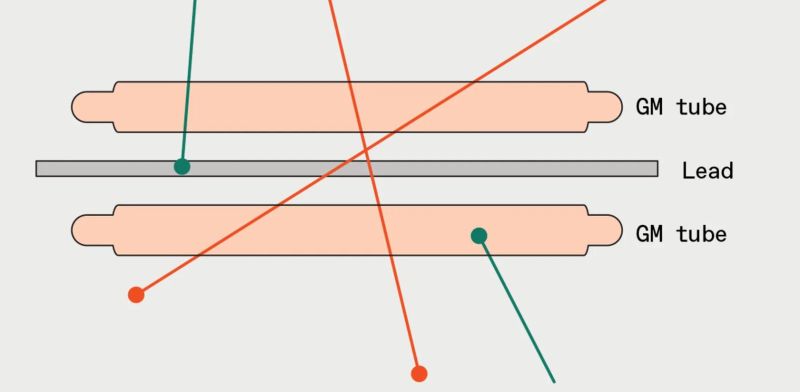Muon tomography, or muography, is the practice of using muons generated by cosmic rays interacting with Earth’s atmosphere to image structures on Earth’s surface, akin to producing an X-ray. In lieu of spending a fair bit of money on dedicated muon detectors, you can also hack such a device together with two Geiger-Müller tubes and related circuitry for about $100 or whatever you can source the components for.
The reason for having two Geiger-Müller tubes is to filter out other much more prevalent sources of ionizing radiation that we’re practically bathed in every second. Helped by a sheet of lead between both tubes, only a signal occurring at the same time from both tubes should be a muon. Specially cosmic ray muons, as these have significantly more kinetic energy that allows them to pass through both tubes. As a simple check it’s helpful to know that most of these muons will come from the direction of the sky.
The author of the article tested this cobbled-together detector in an old gold mine. Once there the presence of more rock, and fewer muons, was easily detected, as well as a surge in muons indicating a nearby void from a mine shaft. While not a fast or super-easy way to image structures, it’s hard to beat for the price and the hours of fun you can have while spelunking.
















Editor:
“In lieu of spending a lot of spending a fair bit of money…”
I couldn’t even type that without getting an angry red underline.
This is only 3 paragraphs.
Please take the 20 seconds to reread it at least once before posting.
You can do it.
I believe in you!
Further:
“Specially” should be “Especially”, since you mean it like ‘Paricularly in the case of cosmic ray muons’, rather than ‘Custom made for him by Fred’.
or array BPW34/BPW64 diode detector?
If that actually works, can you use two arrays to find the angle and make a real camera? Is there some crazy prime number spacing thing where every pair resolves a unique point and you can get better resolution that you’d expect if you wait long enough?
Look up “Golomb ruler” for the crazy prime numberspacing thing.
This technique was used inside the pyramids to look for hidden chambers and shafts.
Yeah, LOTS of errors in that article!
I know that muons were used to find “hidden rooms” in the Great Pyramid in Giza.
The thing I don’t get is that, these muons are supposed to go through solid rock, and any solid material. They’ve gone millions of miles already before they get to Earth.
So, if that’s the case, I don’t understand how they can be used with simple X-ray film (and weeks or months of exposure) to “visualize” voids in the pyramid (or any other structure). I know they’re also used to find such voids in the very old Aztec structures in South & Central America, too. (After they were “proven” with the Giza pyramid.).
I mean, do they lose a certain amount of energy when traveling through rock?! What’s the deal?
I’ve watched TV shows on History channel, where first they talk about how muons go through planets, etc, and any other solid mass, then they talk about using them for imaging voids.
WTF???
“these muons are supposed to go through solid rock, and any solid material. ”
I think you’re confusing neutrinos and muons. Neutrinos at reasonable energies have an interaction cross section so low that they could go through a block of lead from here to Jupiter half the time (at high enough energies they won’t, but that’s super-high).
Muons happily interact just like any other particle, but because they’re heavier than electrons and they also have a fair amount of energy (typically 1 GeV for vertical atmospheric muons, but with a very long tail to higher energies), they can zip through normal material pretty well.
Handy rule of thumb: take the density of something relative to water (so if it’s water, the density’s “1”). Multiply that by 2 MeV, and that’s the amount of energy a relativistic particle loses every centimeter (there’s a silly caveat where if it’s mostly hydrogen it’s higher than that, but whatever – this is the energy loss of a “minimum ionizing particle”).
So for instance, since lead has 11x the density of water, muons lose about 22 MeV per centimeter they go through lead. So obviously if you’ve got like, an inch of lead, they’re only going to lose maybe 50 MeV or so out of the 1 GeV they’ve got. Doesn’t even register.
However, electrons produced from cosmic rays typically have energies of only like 5-10 MeV. So that same inch of lead stops them dead.
Density of rock is like “a couple” times water, so obviously when you’re down 100 meters in a mine, now you’re talking 1E4 cm, so the muons are losing 10+ GeV. Now it’s a lot harder for them to reach, and only the higher energy ones will make it. The number of those drops very fast, and so you’ve got a nice sensitive probe of rock thickness.
To build on this a little more, the muons are not traversing vast distances in space. They are produced in the atmosphere. Galactic cosmic rays, which are the energetic ones, may individually penetrate to the upper atmosphere and collide with a molecule. That creates a shower of secondary particles that continue downwards. That process continues further into the atmosphere, creating more and more particles including nuclear fragments, protons, alphas, electrons and a big dose of muons. The number of particles increases until you reach about 15 km (lookup Pfotzer point), where absorption starts to dominate. By the time this reaches the ground it’s mostly neutrons and muons. It’s pretty common for 1 GCR to result in 10,000 to 1,000,000 secondaries, most of which never reach the ground. This is also why the muon’s flux spreads out fast from vertical. A glancing blow from a GCR creates a tilted shower and still penetrates effectively.
Fun fact – the muons average lifetime is only 2.2 microseconds. Even at the speed of light, that’s only about 700 meters so you wouldn’t expect to see them at ground level or below. But, thanks to special relativity, the lifetime we measure is much longer and they pelt down on us.
Cosmic rays are so cool.
For low energy showers (which is what the vast majority are), that’s basically right, but the cosmic ray flux extends to very high energies (more than 100 EeV) and those showers extend straight down to the ground. Interestingly, at places like the South Pole (where the effective altitude is high) at those energies, the particle shower doesn’t even reach its maximum by the ground.
That’s why if you take two particle detectors at ground and space them out over large distances, you’ll get a coincidence rate way above what you would expect for just 2 random muons. That’s how Pierre Auger first discovered what he called “extensive air showers.” At the highest energies, those extensive air showers spread over city-scale areas (many square kilometers) on the ground.
For those showers (if they’re not super-highly inclined), the flux at ground is dominantly high-energy photons, with a small bit of electrons and on the order of a few percent of the energy in muons.
Made a 7×7 matrix with scintillators and SiPM. Not cheap but works great ! Trajectories can be seen with coincidence detection.
Why not encase just one of the tubes with lead completely?
Xrays degrade led over time.
You mean like.. poke holes in it? Why would the proposed 2-tube scheme still containing lead work?
X rays degrade lead? Seems unlikely for anything short of actually melting it. Do you have a credible reference for that assertion?
How do you “degrade” an element? Cold Fusion?
Indeed, it reacts and produces lead xrayide, unless in the presence of oxygen, in which case it produces gaseous lead xrayate.
Nice one :-)
Using 2 tubes gives you directionality. That’s what makes it a muon telescope (which is a bizarre name for it, I know, but that’s what it is).
Directionality makes some sense, but then it does say muons are likely to only be coming from above anyways.
Per the paper:
“To distinguish the high-energy cosmic-ray muons from the other, lower-energy particles isn’t hard, though. Just apply what physicists call the coincidence method: Detect only when two nearby tubes are triggered practically simultaneously, meaning one particle has barreled through both tubes. The two tubes in my device are separated by 25-millimeter spacers, making it unlikely that a particle coming from a nearby radioactive decay would be energetic enough to pass through both tubes. I reduced the likelihood even more by placing a layer of fishing-sinker lead between the tubes.”
I think it might be a stacking of features here.
A single tube encased in lead might get some other stray particles still.
But for a particle to come through both tubes the lead, AND be coming in a vertical axis? That makes it much more likely to be a muon.
No, a counter encased in lead would be a perfectly good muon detector, it just wouldn’t be able to do anything directional. The directionality isn’t what filters out low-energy particles, it’s all about the lead.
No, they come from all angles. The reason they’re “coming from above” underground is because there’s more rock at angles other than vertical. They also “come from above” at the surface but again that’s because you’re “closer to the source” going straight up, too. But there’s more “sky” from all angles rather than vertical, so in the end, you get roughly equal muons from any patch in the sky at the surface. Very roughly: as you go closer to the horizon that changes because you start cutting out the lower energy guys.
Different when you go underground, because now you’re purely into the high-energy muons, so now it only matters the least amount of rock above you.
It’s 100% about directionality. When you space the two tubes apart, you select muons coming from a direction aligned along the separation between the tubes. That’s how in the article he’s measuring the falloff with angle.
The directionality is greatly improved when the tubes are further apart, reducing the solid angle that describes the path muons can take and hit both detectors. At the same time, this would reduce the number of captured muons.
The total flux is only about one event per minute per square centimeter at the surface, so you’d have to wait quite a while for enough events to see a difference in rock density, and that’s only a single pixel of the muon camera.
Yeah, although if you’re building a muon telescope you don’t make it a square centimeter. Usually you’re talking closer to square meter scale, so it doesn’t take that long. The advantage that you have is that the spectrum falls extremely fast with energy, so the overall rate is a very strong function of the amount of material between you and the sky.